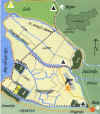|
THE SALT - PANS TODAY
SECOVLJE SALT - PANS - A RAMSAR SITE THE SECOVLJE SALT-PANS WERE DUE TO THEIR EXCEPTIONAL LANDSCAPE AND ECOLOGICAL VALUE IN 1993 INCLUDED, AS THE ONLY WETLAND IN SLOVENIA, INCLUDED ON THE LIST OF RAMSAR SITES. The Ramsar Convention was adopted, within the framework of UNESCO, in February 1971 in the Iranian town of Ramsar as the Convention on Wetlands of International importance, especially as Waterfowl Habitat. This international agreement on conservation and wise use of wetlands, which should prevent a further destruction of such habitats, has been to date signed by more than 100 countries all over the world. Salt-pans are certainly among the most endangered wetlands in the Mediterranean. As a result of the ecologically unfriendly development in this century, this picturesque element of the Mediterranean cultural landscape is virtually disappearing before the eyes of our generation, the element which has with its strategic significance and cultural tradition played an important role in the development of the Mediterranean civilizations up to the present day. Disappearing together with them, however, is also the extremely rich life, closely associated with the unique salt-pans ecosystems. PROTECTIVE LEGISLATION In order to preserve the Secovlje salt-pans as a characteristic landscape element and as an area rich natural and cultural heritage, the protective legislation as defined in the decree clearly stipulates that all those activities are limited which have a negative impact on the ecology of the landscape and its outer form. Prohibited are especially all kinds of hunting, any pollution of air, water and soil, construction of dense settlement on Seca peninsula, any changes in land-use and, particularly in nature reserves, any human intervention which would change the living conditions for the local flora and fauna. Also prohibited is to pick plants as well as to damage habitats and nest sites of the local animals. Any encroachments upon nature in Secovlje Salt-pans Landscape Park are possible only on the basis of a preliminary consent given by the Regional Institute for Conservation of Natural and Cultural Heritage Piran. |
|
To enter the area of the Secovlje salt-pans along the road, an identity card or a passport is needed, as the Slovene part of the Secovlje border crossing has to be passed. Then the visitor is to turn right to the tarmac road which will bring him, past the abandoned salt fields, to the Museum of Salt-making. An access from the sea is also being planned, which will be much less disturbing for the plant and animal life in the pans. The Museum of salt-making is from April to November open from 9 to 12 and 15 to 18, from July to August from 9 t0 12 and 16 to 19. During the rest of the year the Museum is closed, except for groups of a least 10 people, if previously agreed with the Marine Museum "Sergej Masera".
|



 On
the basis of the decree issued in 1989 by the Piran council, the
area of the Secovlje salt-pans and Seèa peninsula was
proclaimed a landscape park. This was the consequence of its
extremely rich natural and cultural heritage as well as the wish
to preserve the pans as a characterictic morphological element
of the littoral cultural landscape of Slovene Istra. The area of
the pans wirhin the park was due to its exceptional cultural
tradition, which includes architectural, technical,
technological, ethnological and language heritage, further
decreed and ethnological and technical monument, while the four
smaller salt-pans areas - the so-called Ob rudniku, Stare soline,
Stojbe and Curto-Pichetto - were given the status of nature
reserves.
On
the basis of the decree issued in 1989 by the Piran council, the
area of the Secovlje salt-pans and Seèa peninsula was
proclaimed a landscape park. This was the consequence of its
extremely rich natural and cultural heritage as well as the wish
to preserve the pans as a characterictic morphological element
of the littoral cultural landscape of Slovene Istra. The area of
the pans wirhin the park was due to its exceptional cultural
tradition, which includes architectural, technical,
technological, ethnological and language heritage, further
decreed and ethnological and technical monument, while the four
smaller salt-pans areas - the so-called Ob rudniku, Stare soline,
Stojbe and Curto-Pichetto - were given the status of nature
reserves.